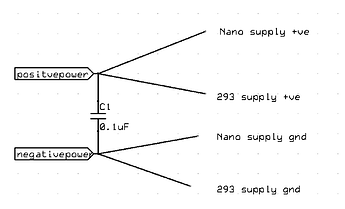Hello to everyone!
I'm trying to modify a model train with an Arduino Nano and I'm having some problems with a digital pin set as INPUT_PULLUP not going to LOW when I connect it to GND.
I attach the code and a schematic below, the basic idea is that the Arduino Nano has to receive commands to start / stop / change speed via Bluetooth from the HC-05, and drive the motor in the model train through the L293D chip. The power supply consists of a 18650 battery holder with two cells connected in series. Also, the model train has to detect magnets along the tracks with a reed switch, and send a message over Bluetooth when is does. To do this, I set the pin D2 as INPUT_PULLUP, connected D2 to one of the sides of the switch, and the other to ground.
The problem is that when I turn on the motor, there is no way to make the pin D2 (connected to the reed switch) to get LOW, even connecting it directly (or through a resistor) to GND doesn't make it LOW, and so it doesn't trigger the interrupt (I also tried checking if it’s LOW in the loop function, but no use). However, if I stop the motor, the this problem goes away and the interrupt and reed switch work every time.
So far I’ve tried to use a 5.2KOhm resistor between the output of the switch and GND (works when the motor is stopped, otherwise also no), I’ve tried putting a 5.2KOhm resistor between D6 and the L293D, and D7 and the L293D, and a 10Ohm resistor between D5 (PWM) and the PWM input of the L293D (which also slowed down the motor), but the problem on D2 persists.
What am I missing?
//
// Pinout description: (ARDUINO UNO / NANO)
// DIGITAL:
// 2 } - Reed switch
// 3
// 4
// 5 } - L293D - { Enable
// 6 } { DIR_B
// 7 } { DIR_A
// 8
// 9
// 10
// 11
// 12
// 13
// TX -> HC-05 RX
// RX -> HC-05 TX
// Constants
const unsigned long ACCESS_KEY = 2107106630;
const byte MOTOR_MAX_POWER = 100;
const byte MOTOR_MIN_POWER = 85;
const float MAX_SPEED_LIMIT = 255;
const unsigned short SOFTWARE_DEBOUNCING_WAIT = 250; // ms
// Define pinout
const byte REED_SWITCH_PIN = 2;
const byte MOTOR_ENABLE_PIN = 5;
const byte MOTOR_DIR_A_PIN = 6;
const byte MOTOR_DIR_B_PIN = 7;
const unsigned short SERIAL_BAUD_RATE = 57600;
// Variables
volatile bool reedSwitchClosed = false;
volatile long lastReedSwitchClosedTime = 0;
enum CommunicationMessageServerToClient {
FORWARD = 1,
BACKWARD = 2,
FAST_STOP = 3
};
enum CommunicationMessageClientToServer {
REED_TRIGGERED = 1,
};
void setup()
{
// Initialize the pin and interrupt for the reed switch
pinMode(REED_SWITCH_PIN, INPUT_PULLUP);
attachInterrupt(digitalPinToInterrupt(REED_SWITCH_PIN), onReedSwitchClosed, FALLING);
// Initialize the pins for the L293D motor controller
pinMode(MOTOR_ENABLE_PIN, OUTPUT);
pinMode(MOTOR_DIR_A_PIN, OUTPUT);
pinMode(MOTOR_DIR_B_PIN, OUTPUT);
// Open a (hardware) serial connection with the HC-05 BlueTooth module
Serial.begin(SERIAL_BAUD_RATE);
// Log in the the ground control software through BlueTooth
blueToothLogin();
}
void blueToothLogin()
{
// When the ground control server is ready, it sends a byte of all ones (255) and awaits for the token
// Wait for the "ready" byte to come
while (Serial.available() == 0) {}
Serial.read();
// Send the authentication token
Serial.write((byte*)&ACCESS_KEY, sizeof(unsigned long));
}
void onReedSwitchClosed()
{
if (millis() - lastReedSwitchClosedTime < SOFTWARE_DEBOUNCING_WAIT)
{
lastReedSwitchClosedTime = millis();
return;
}
lastReedSwitchClosedTime = millis();
reedSwitchClosed = true;
}
void loop()
{
if (reedSwitchClosed)
{
Serial.write(1);
Serial.write(CommunicationMessageClientToServer::REED_TRIGGERED);
reedSwitchClosed = false;
}
while (Serial.available())
{
receiveIncomingCommunicationMessage();
}
}
void receiveIncomingCommunicationMessage()
{
byte size = Serial.read();
byte message[size];
for (byte i = 0; i < size; i++) {
int b = Serial.read();
if (b == -1)
{
i--;
}
else
{
message[i] = b;
}
}
processIncomingMessage(message);
}
void processIncomingMessage(byte message[])
{
switch (message[0])
{
case CommunicationMessageServerToClient::FORWARD:
{
goForward(message[1]);
break;
}
case CommunicationMessageServerToClient::BACKWARD:
{
goBackwards(message[1]);
break;
}
case CommunicationMessageServerToClient::FAST_STOP:
{
fastStop();
break;
}
}
}
void goForward(byte speedLimit)
{
lastReedSwitchClosedTime = millis();
byte motorSpeed = convertSpeedLimitToMotorSpeed(speedLimit);
analogWrite(MOTOR_ENABLE_PIN, motorSpeed);
digitalWrite(MOTOR_DIR_A_PIN, HIGH);
digitalWrite(MOTOR_DIR_B_PIN, LOW);
}
void goBackwards(byte speedLimit)
{
lastReedSwitchClosedTime = millis();
byte motorSpeed = convertSpeedLimitToMotorSpeed(speedLimit);
analogWrite(MOTOR_ENABLE_PIN, motorSpeed);
digitalWrite(MOTOR_DIR_A_PIN, LOW);
digitalWrite(MOTOR_DIR_B_PIN, HIGH);
}
void fastStop()
{
analogWrite(MOTOR_ENABLE_PIN, 255);
digitalWrite(MOTOR_DIR_A_PIN, LOW);
digitalWrite(MOTOR_DIR_B_PIN, LOW);
}
byte convertSpeedLimitToMotorSpeed(byte speedLimit)
{
float relativeSpeed = float(speedLimit) / MAX_SPEED_LIMIT;
return MOTOR_MIN_POWER + (relativeSpeed * (MOTOR_MAX_POWER - MOTOR_MIN_POWER));
}

